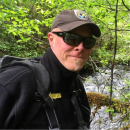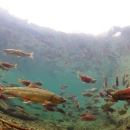Achieving recovery of bull trout throughout their range will require a variety of actions targeting limiting factors in an effort to achieve minimum viable population sizes that can persist into the future. This project evaluated empirical information in an effort to relate effective population size theory to absolute abundance and population genetic variability, addressing potential limiting factors, and, ultimately, providing information toward defining minimum viable population requirements for bull trout. The objectives of the project were: 1) Determine abundance of bull trout populations above the Wallowa Valley Irrigation Canal (WVIC) as well as an area of reference unaffected by the WVIC; 2) Determine if there is connectivity (movement) between bull trout populations; 3) Determine within and among population genetic variability for five local populations of the Imnaha River core area; 4) Determine effective population size for potentially isolated populations above the WVIC as well as within a reference areas; 5) Determine bull trout occupancy throughout the Imnaha River core area using the patch analysis approach; and, 6) Determine if there is congruence between local populations identified by genetic means and patch analysis. To achieve these objectives, abundance was estimated in three local populations, connectivity evaluated using PIT technology, genetic analysis was conducted and occupancy assessed in habitat predicted to support bull trout in the Imnaha River core area. The three populations investigated appear to be stable in abundance and have varying degrees of connectivity with each other and additional populations in the core area. The genetic analysis supported the connectivity results and the identification of discrete local populations through a bull trout patch identification process using habitat metrics known to support bull trout populations. Despite low effective population size, two populations that are potentially isolated or where migratory corridors are obstructed, have persisted for over a century. The findings indicate that relatively small bull trout populations can persist with no significant evidence of genetic drift, even when potentially isolated, raising questions on interpretation of the “50/500” rule relative to recovery of this species. However, recovery actions to improve connectivity among populations will likely make populations more demographically stable and less vulnerable to stochastic events.
Publication date
Type of document
Report
Facility
Program
Species
FWS Focus
Ecosystem
FWS and DOI Region(s)





